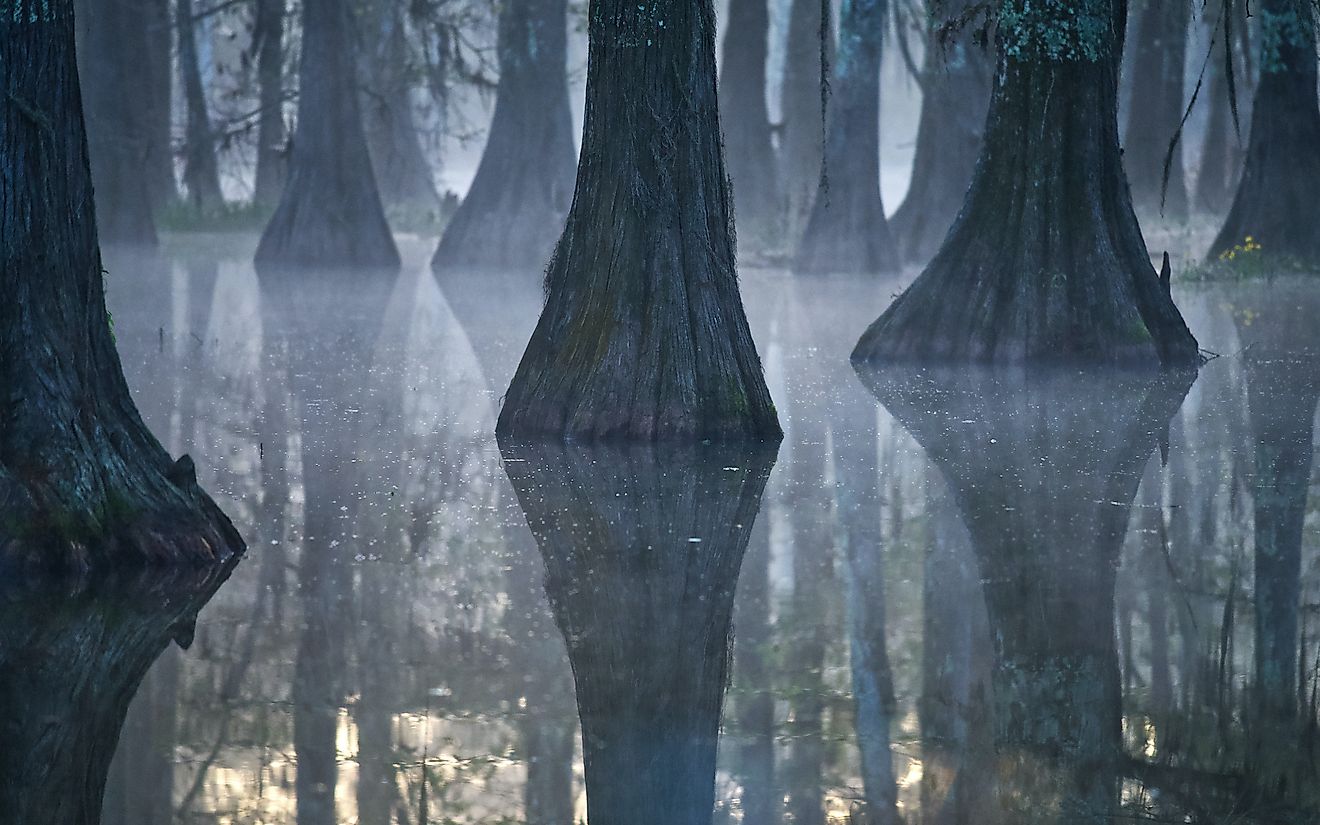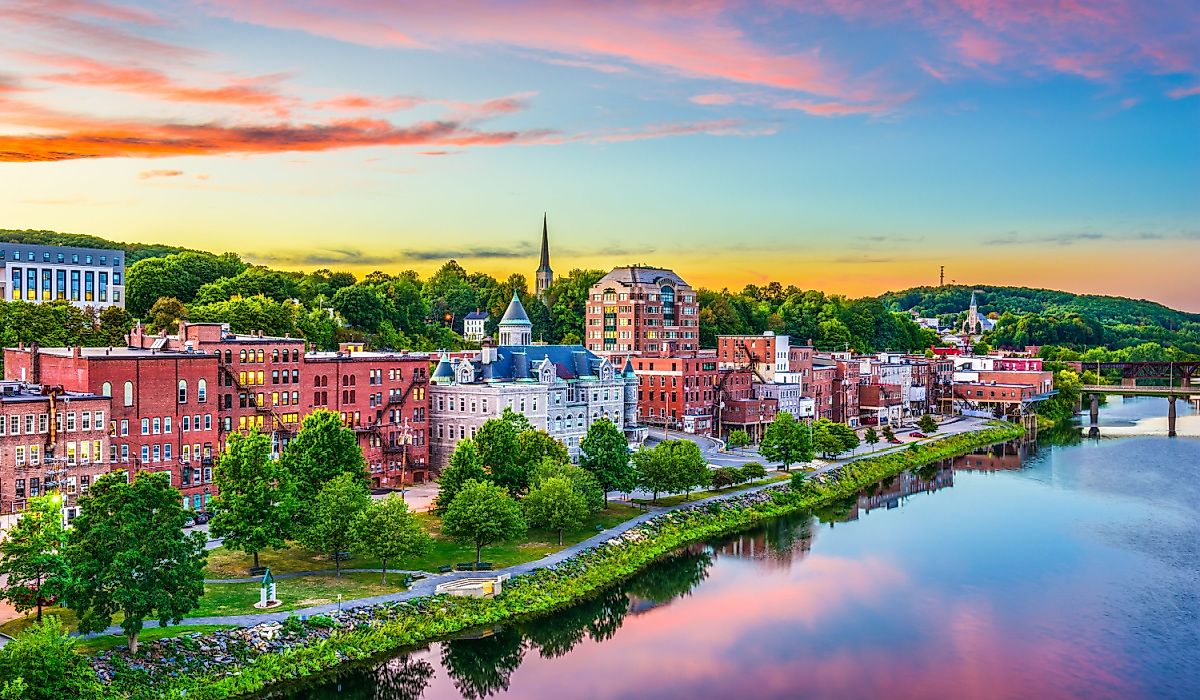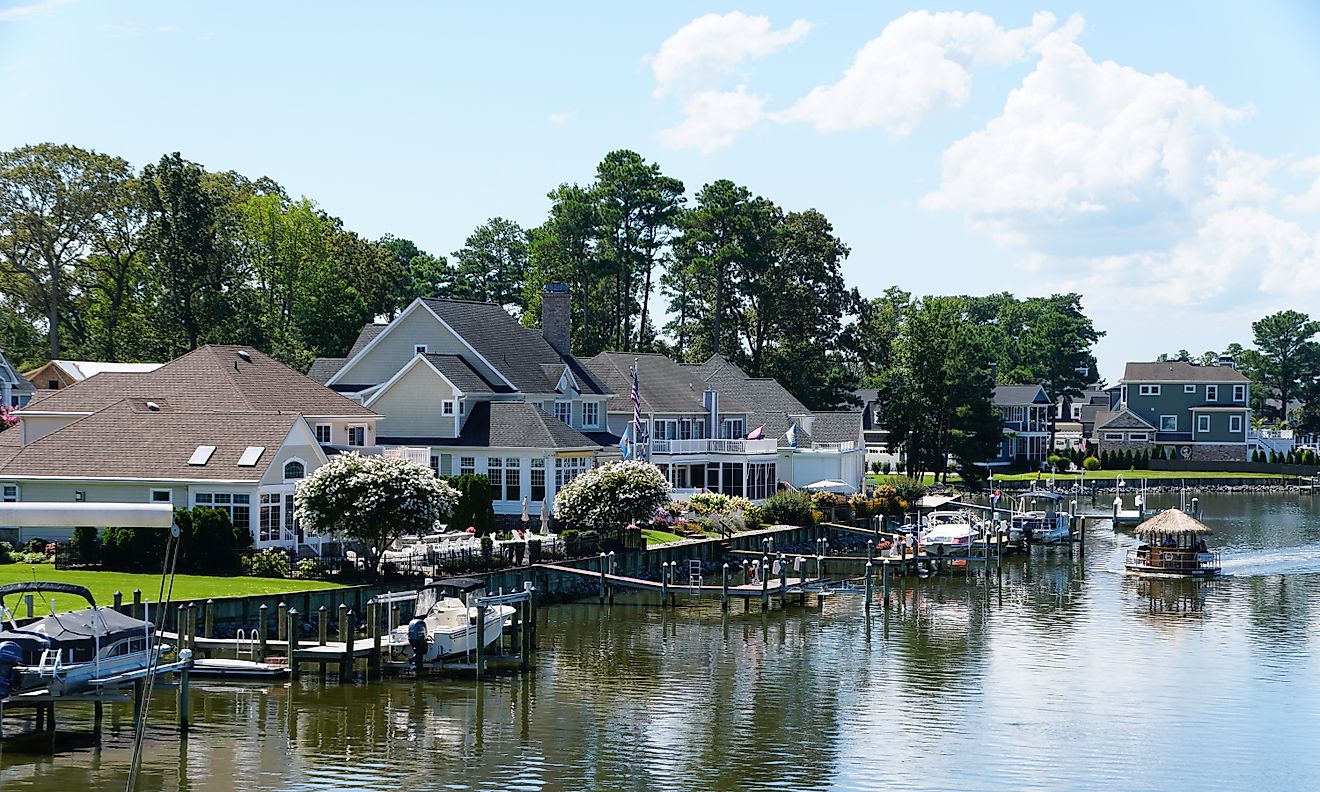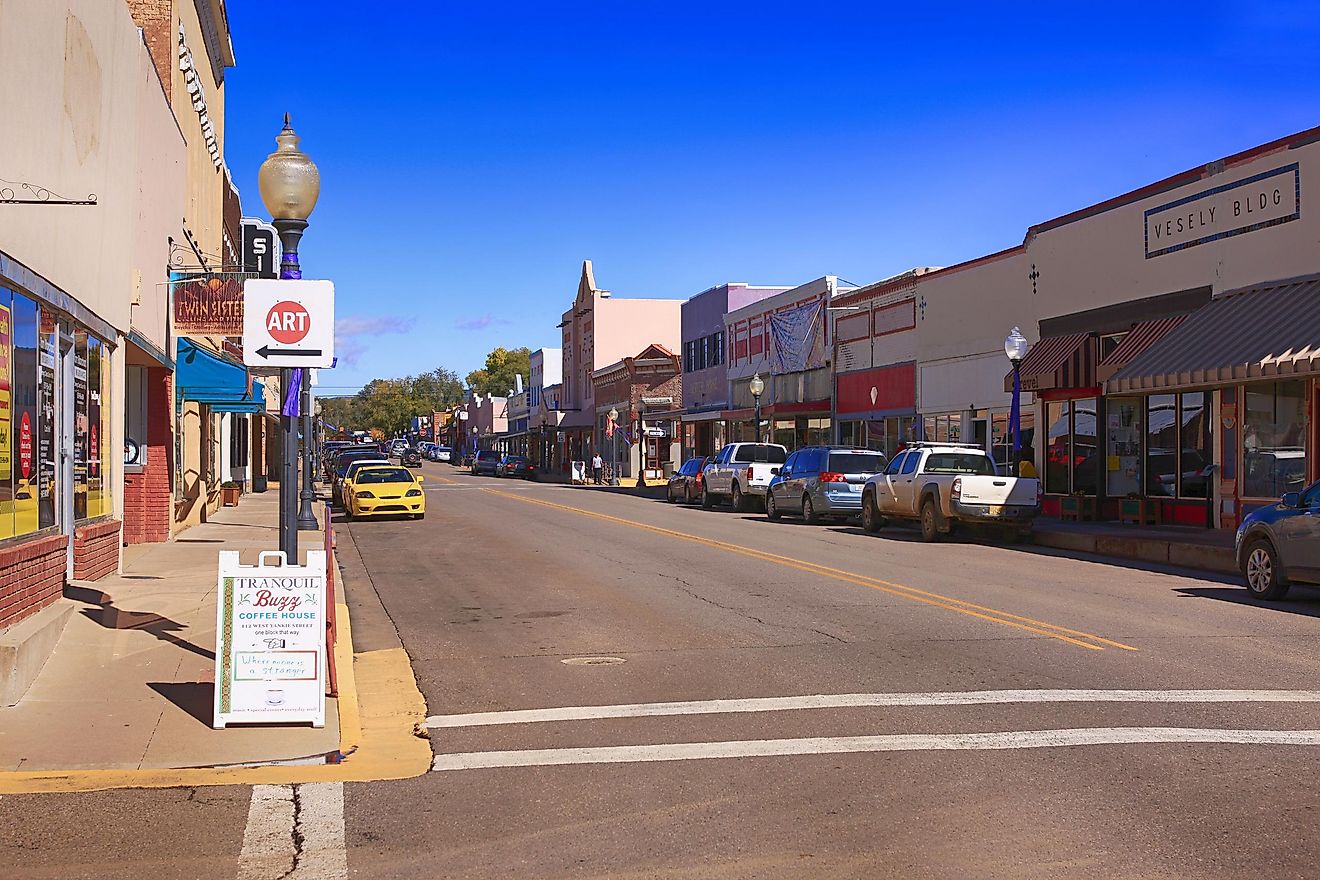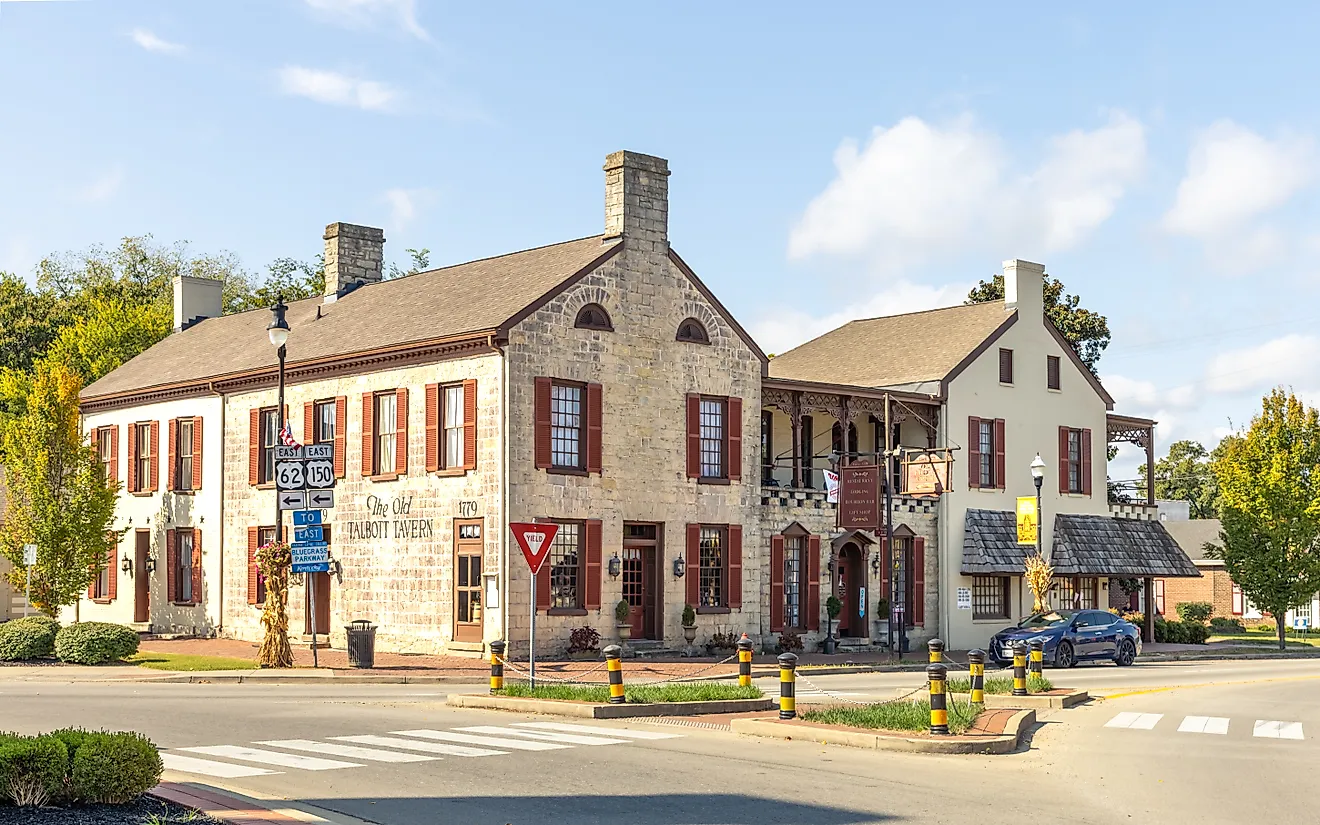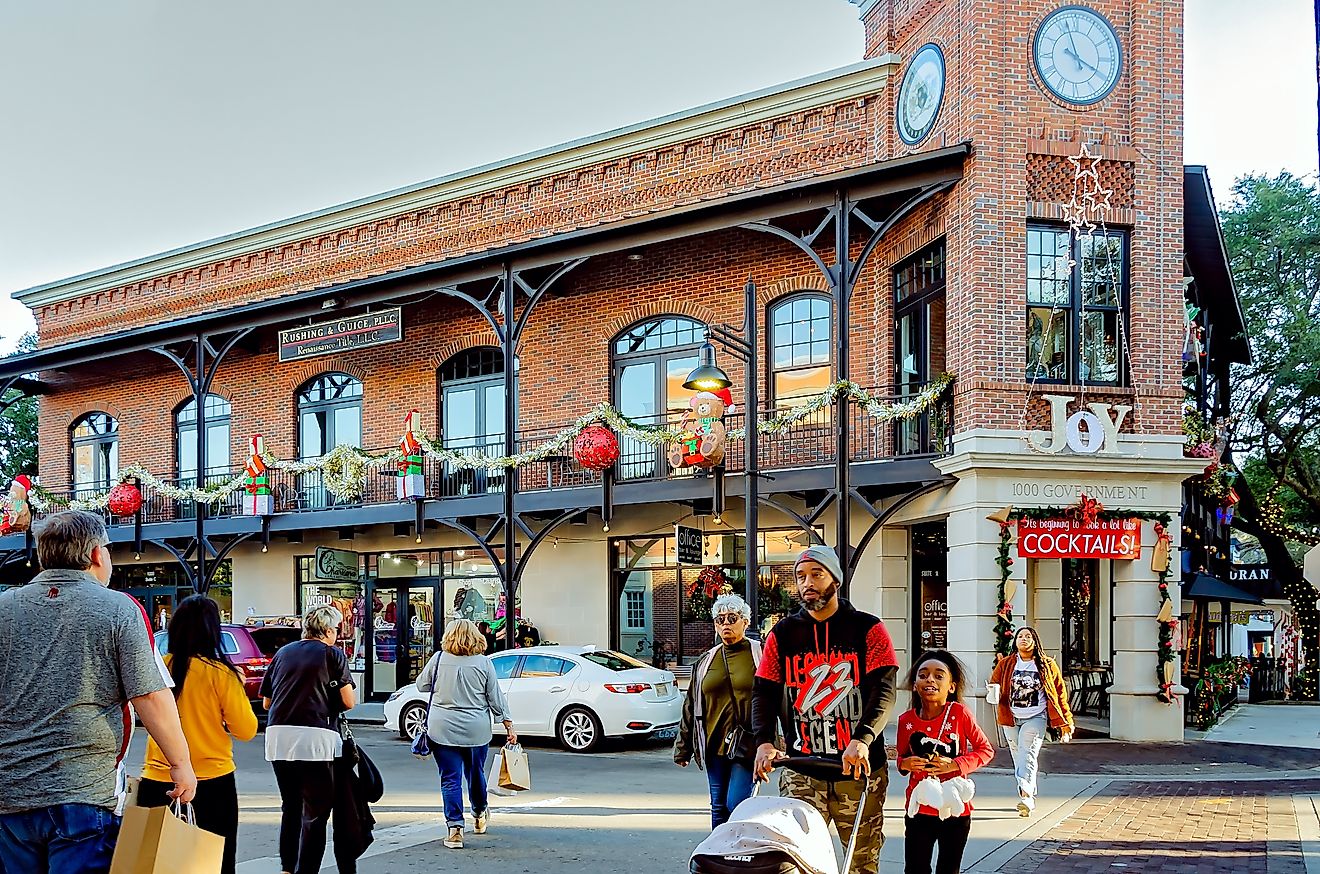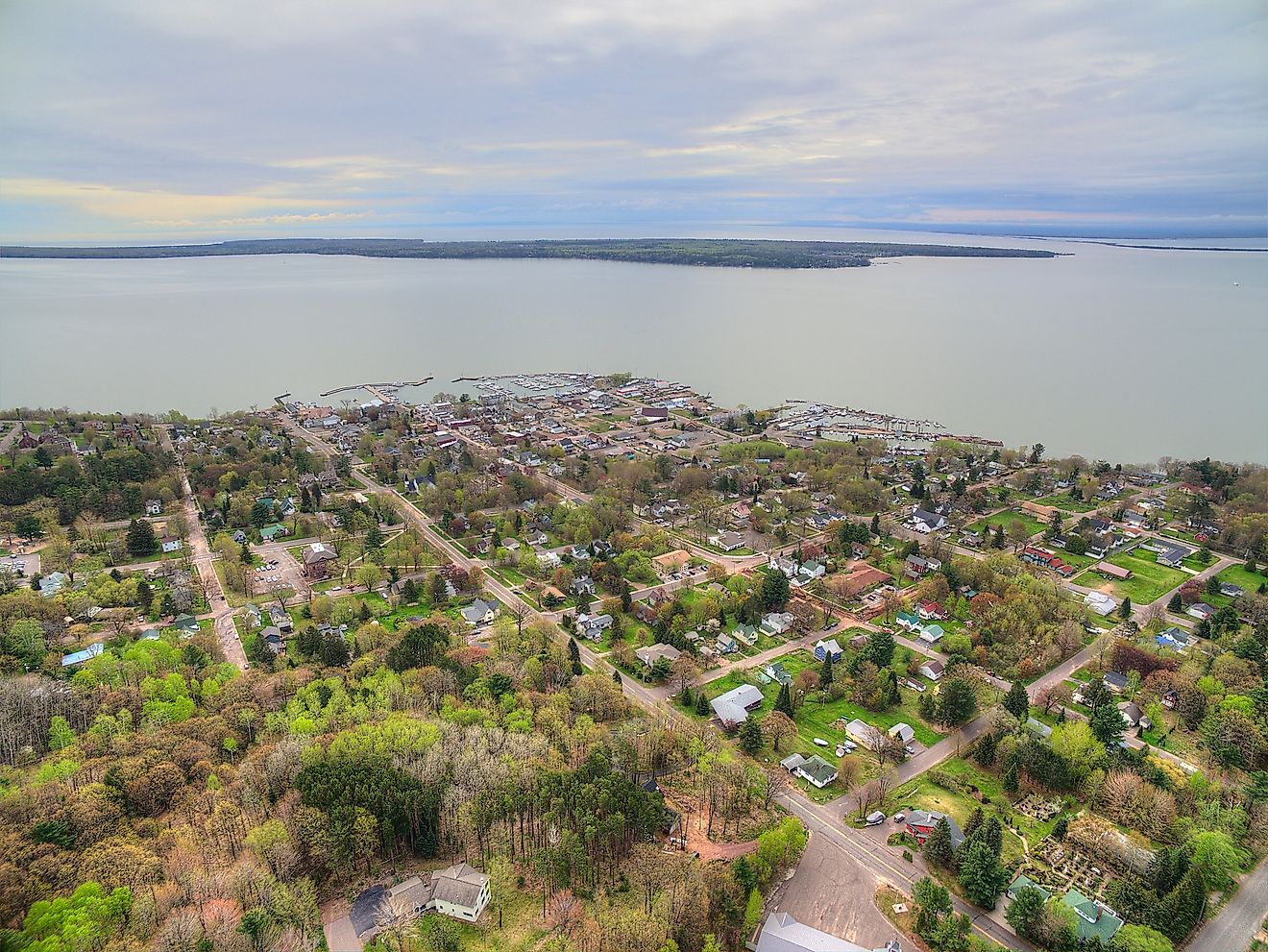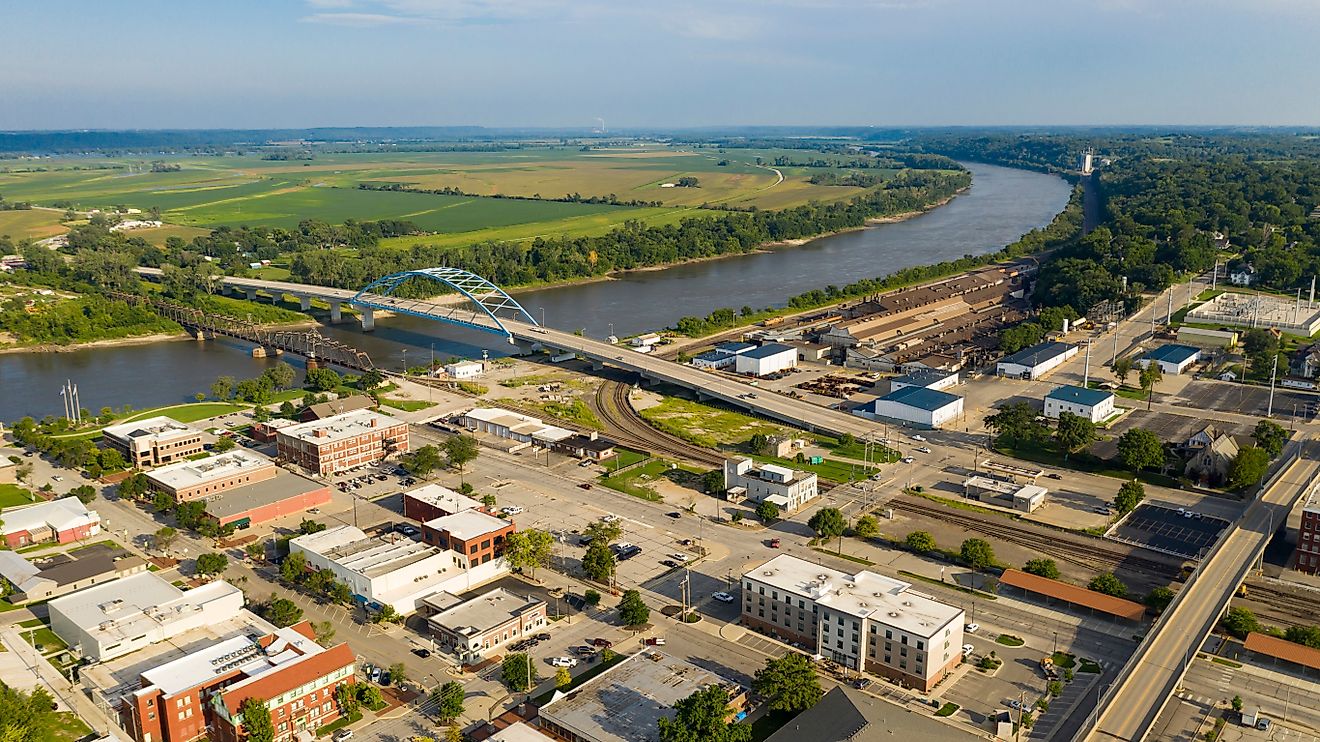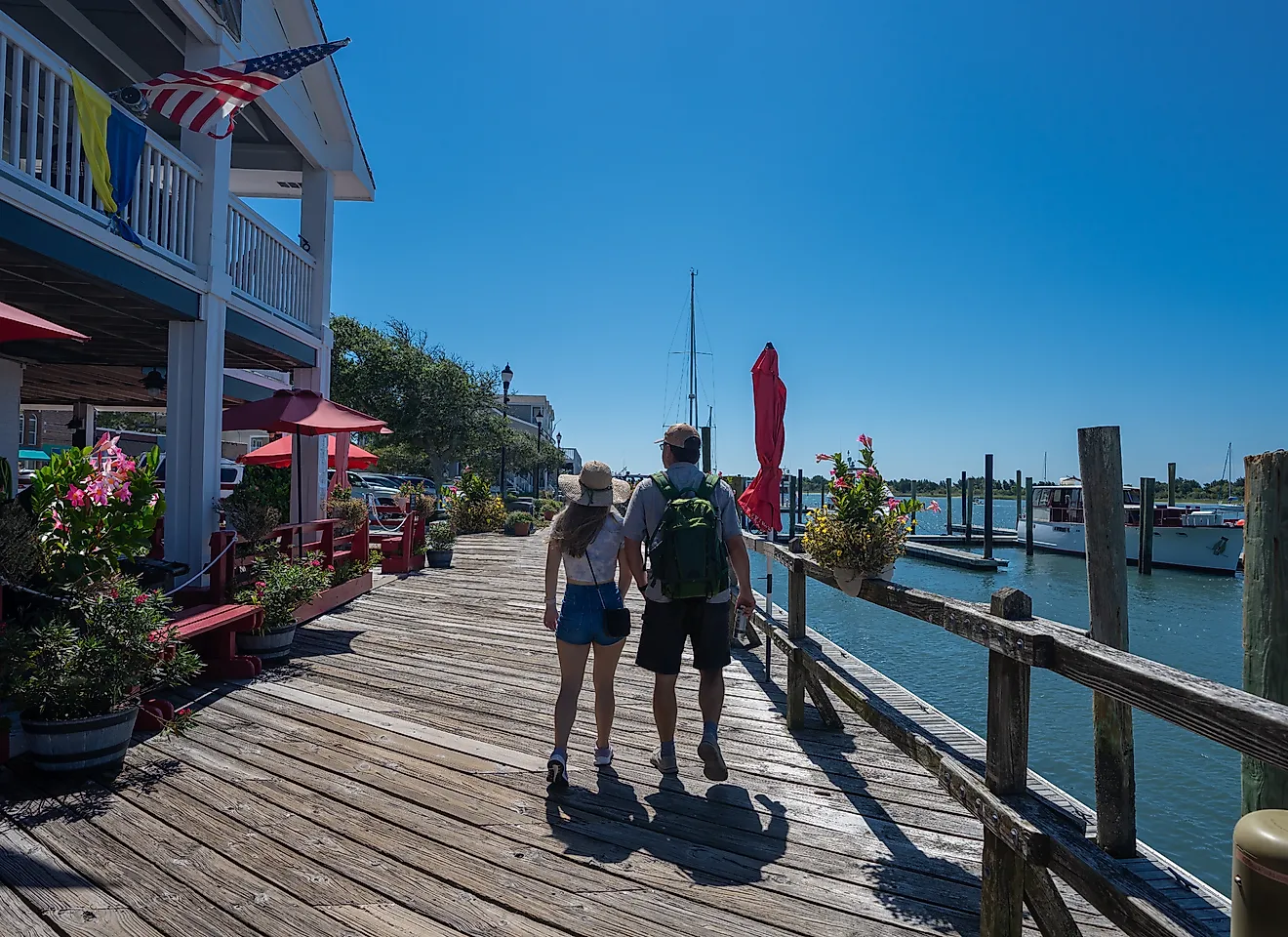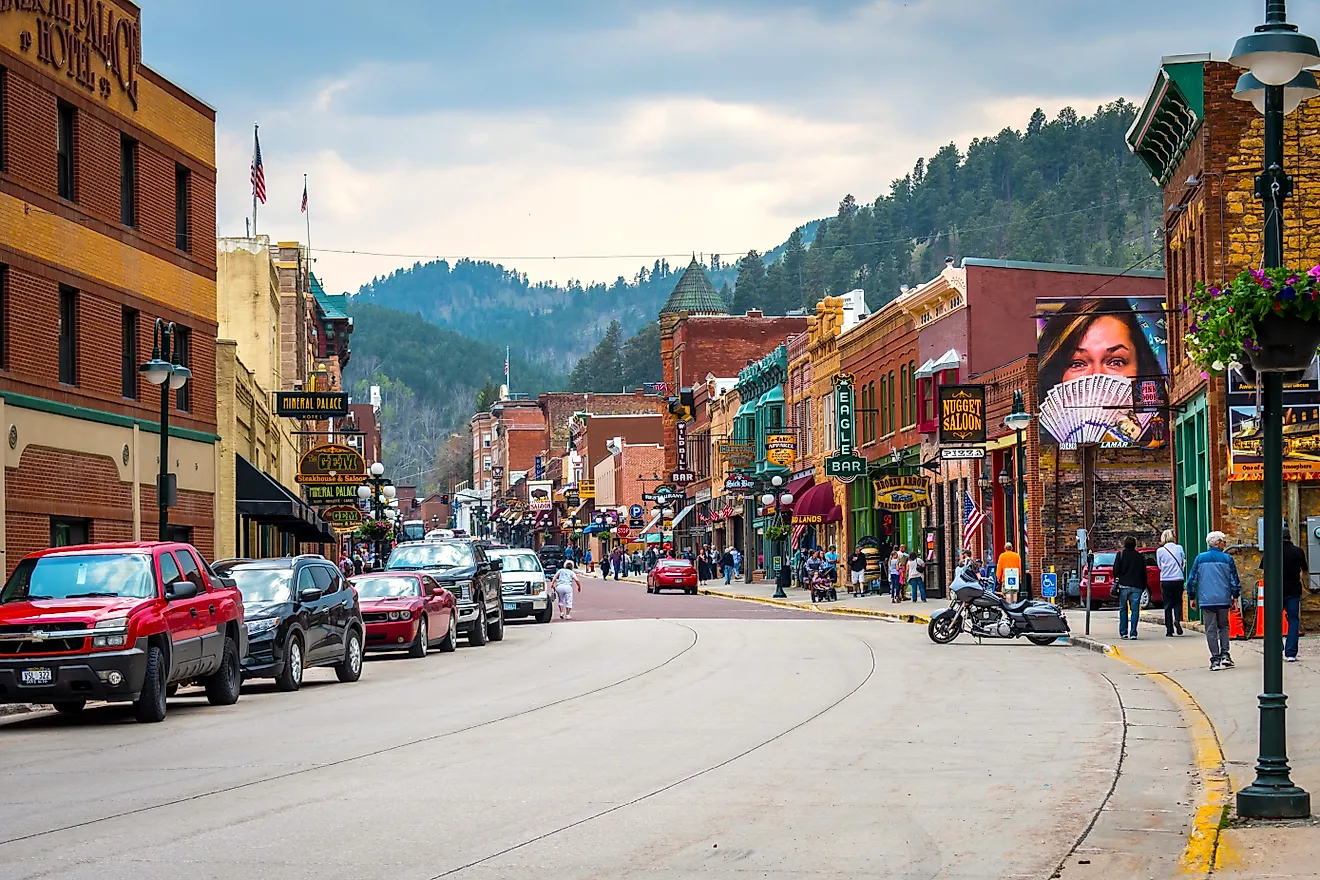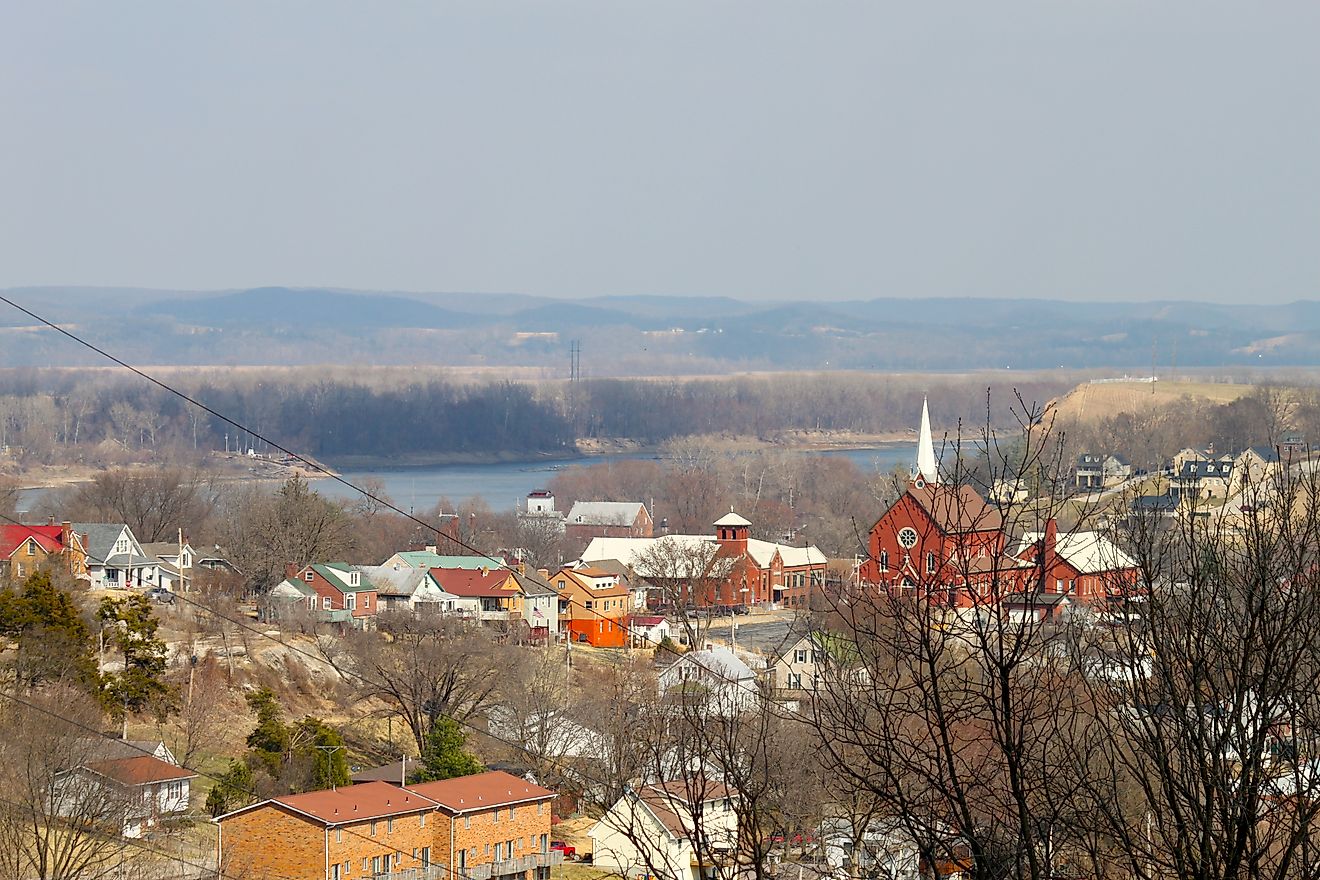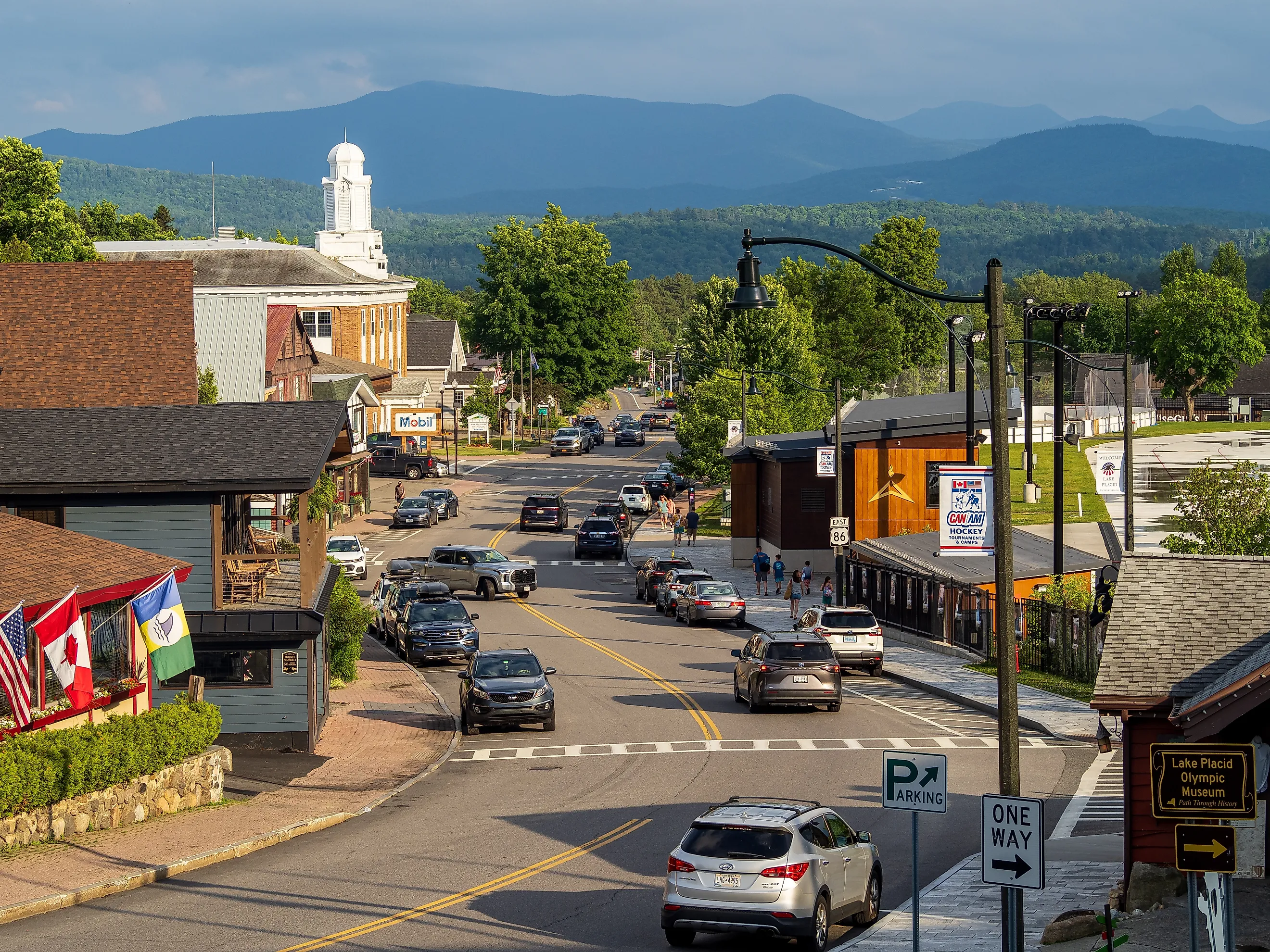
12 Best Upstate New York Towns For Retirees
Retirement in Upstate New York is really a question of water. These towns were built around what moves, spring, fall, lake, river, and the daily rhythm still follows it. Saratoga pours mineral carbonic water right out of the ground; Ithaca threads waterfalls through its street grid; Lake Placid keeps an Olympic oval beside Mirror Lake; Kingston lines up old canal and riverfront like a living diagram of the Hudson economy. The result is a region where the morning loop might be a lakeside path, the matinee a college museum, and the evening a train whistle or a chamber recital in a repurposed city hall.
In these towns, the winters are honest and the infrastructure is older but intact, brick, stone, and rail bones that were overbuilt for industry and now suit quieter lives. Twelve towns, each with its own water story, prove that “retiree-friendly” can mean compact, connected, and visually clear.
Saratoga Springs
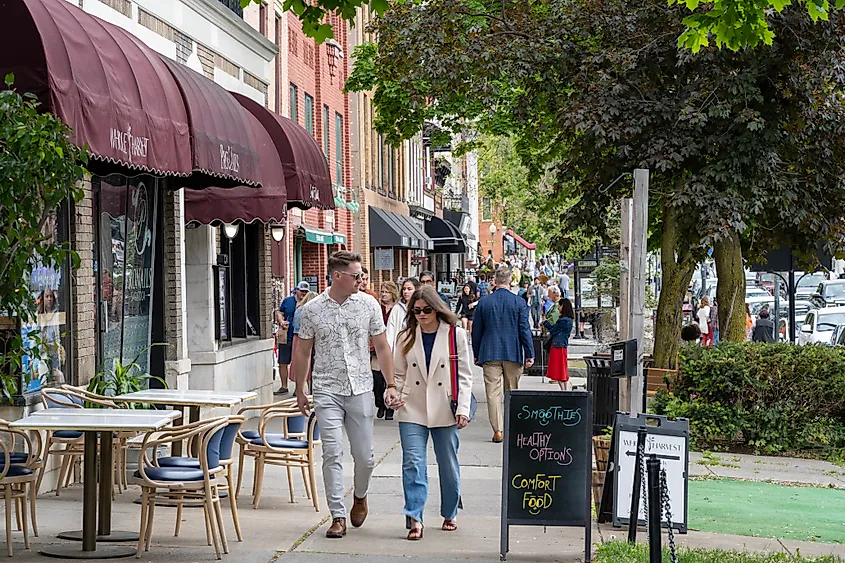
The mineral springs that gave Saratoga Springs its name still flow through the city’s public parks, each one naturally carbonated, each with its own distinct taste. Long before wellness retreats became trendy, Saratoga was already a health resort, drawing 19th-century visitors for its curative waters and setting the tone for the town’s measured pace and restorative atmosphere. That legacy remains intact. Broadway, the main thoroughfare, is walkable and tree-lined, with a clean mix of Victorian buildings, boutique hotels, and medical offices. The town's population sits comfortably under 30,000, yet the cultural infrastructure rivals larger cities thanks to its tourism roots and Skidmore College's influence.
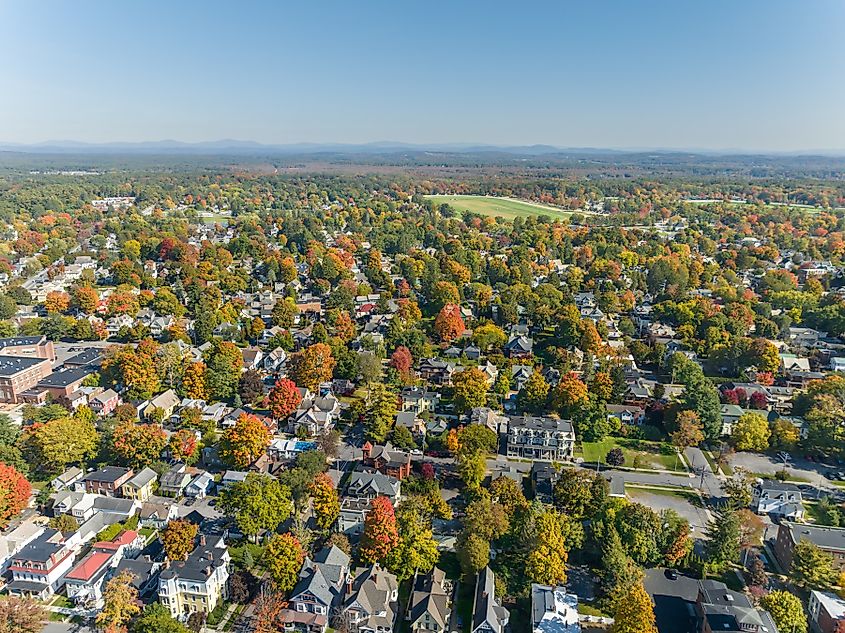
The city’s strongest draw is the Saratoga Performing Arts Center (SPAC), a sweeping amphitheater in the pine-covered Saratoga Spa State Park. It's home to the New York City Ballet and Philadelphia Orchestra each summer. For daily rhythms, locals gather at Uncommon Grounds Coffee & Bagels or stroll through Congress Park to sip from the mineral fountains. The Saratoga Race Course, operating since 1863, adds seasonal energy without overwhelming the town. On quiet weekdays, the Tang Teaching Museum at Skidmore offers smart rotating exhibitions, art without pretense.
Ithaca
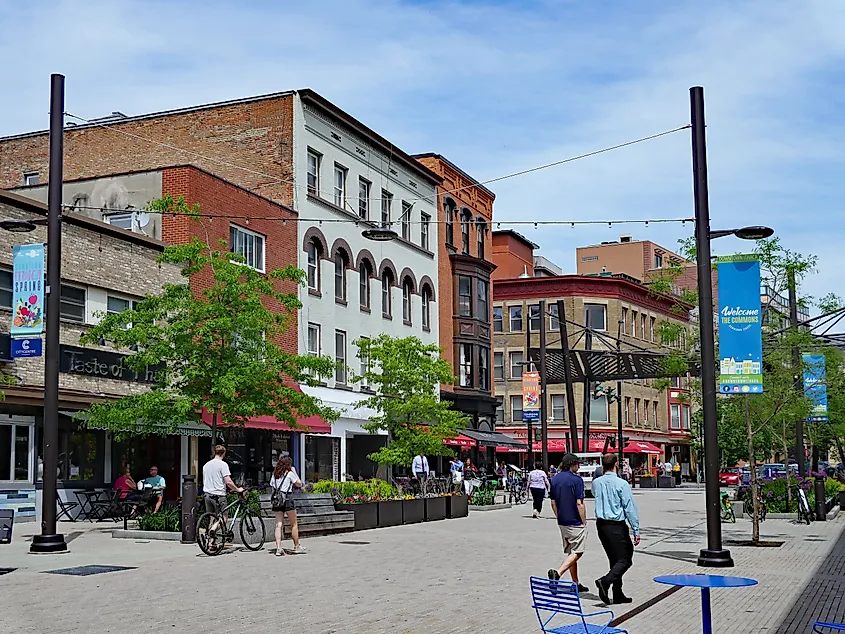
Ithaca’s defining feature isn’t Cornell or Cayuga Lake, it’s elevation. The town was built in a glacial valley but rises quickly into wooded ridges, making nearly every walk or drive shift between lake-level calm and hillside isolation. What results is a rare layout: quiet neighborhoods tucked into forested inclines, less than five minutes from a college town’s core. The waterfall count is unusually high, over 150 in Tompkins County alone, with Ithaca Falls and Cascadilla Gorge Trail cutting directly through town. This gives retirees year-round access to short, accessible hikes with consistent visual payoff.
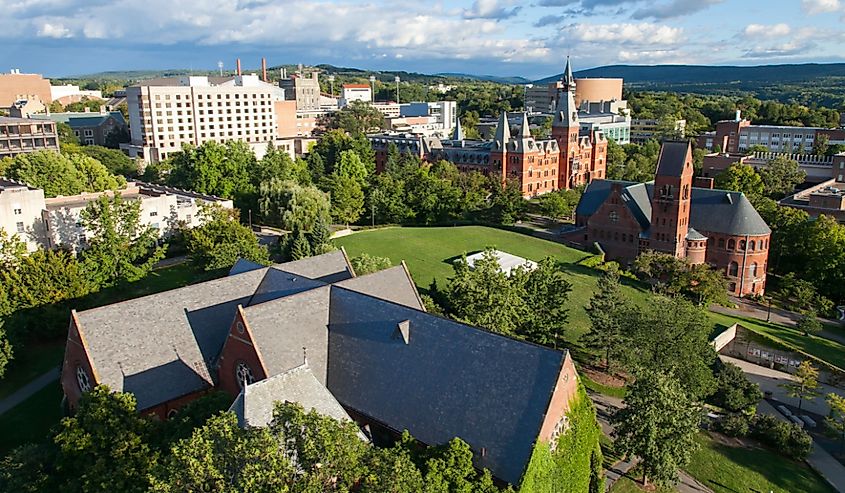
The Ithaca Commons anchors downtown with a pedestrian zone lined by used bookstores, coffee shops, and public art. The State Theatre of Ithaca, a preserved vaudeville-era stage, programs classic films, folk concerts, and spoken word. For lunch or early dinner, Moosewood Restaurant continues to serve vegetarian meals drawn from the famed cookbook series it inspired. The Cornell Botanic Gardens, free and open daily, run alongside Beebe Lake and include both native plant collections and cultivated garden areas.
Cooperstown
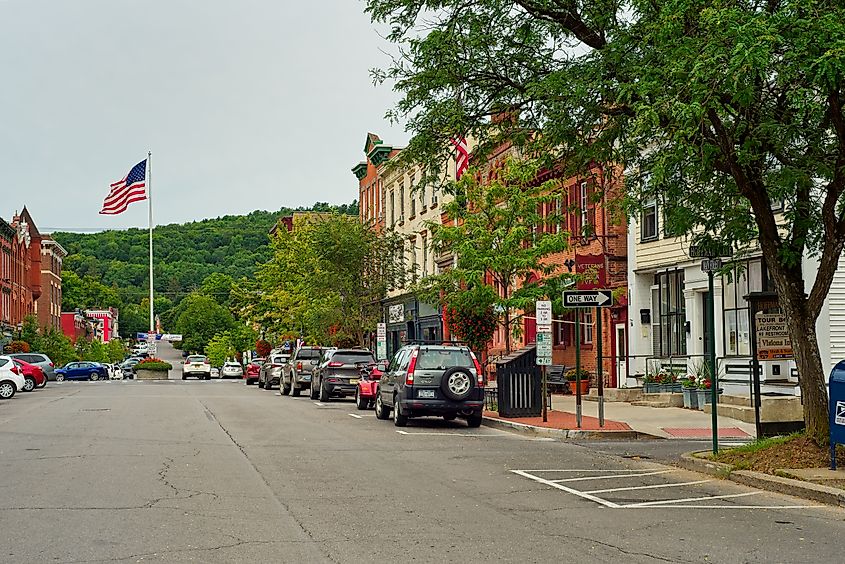
Cooperstown was founded by the father of James Fenimore Cooper, and his literary presence still threads the village. Otsego Lake, which he called Glimmerglass, begins just north of Main Street, bordered by the 500-acre Glimmerglass State Park and a public pier that cuts into the water’s southern tip. The town’s grid is narrow and walkable, lined with 19th-century brick buildings that house local institutions, not chains. There’s no sprawl. Residential areas are close to the village core, and the streets quiet down by early evening year-round, except during Hall of Fame Induction Week.
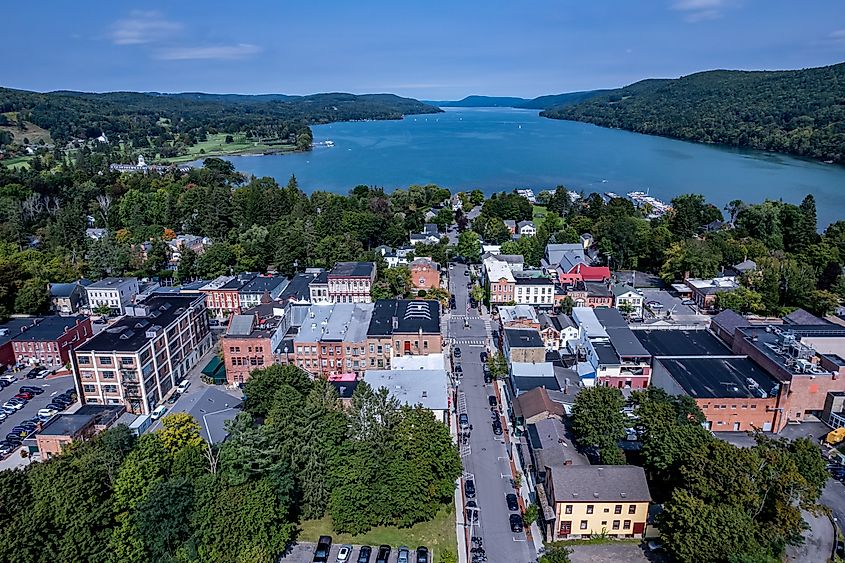
The National Baseball Hall of Fame is Cooperstown’s anchor, but retirees tend to spend more time at the Fenimore Art Museum. Its rotating exhibitions draw from American folk art, the Thaw Collection of Indigenous Art, and visiting shows that tour from larger cities. The adjacent Farmers’ Museum includes a 19th-century working village with costumed interpreters, historic buildings, and livestock. For everyday routines, Stagecoach Coffee serves breakfast and lunch on Pioneer Street.
Lake Placid
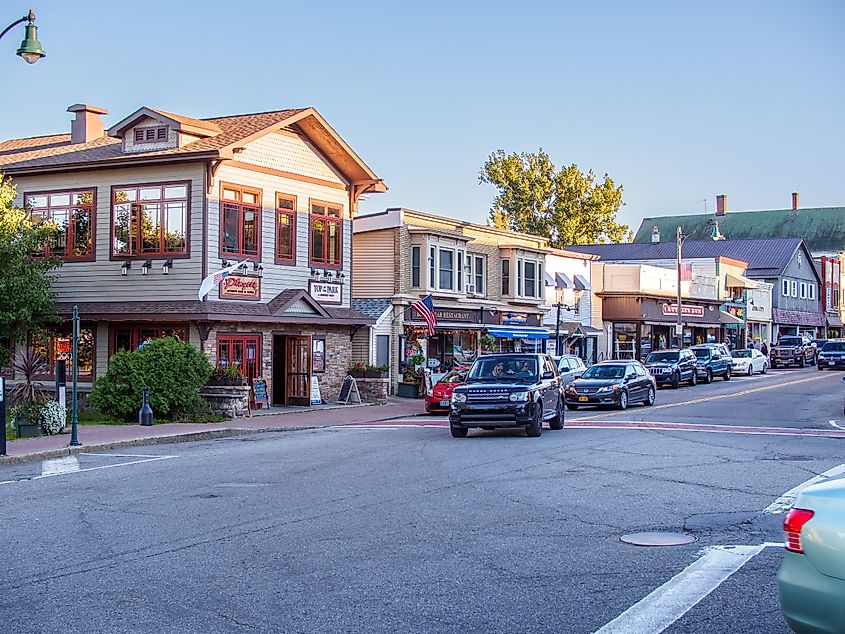
Lake Placid is one of only three towns in the world to host the Winter Olympics twice, and it remains structured around that legacy. Unlike other resort towns, its civic infrastructure was built for international crowds, then handed back to a small permanent population. This created an unusual balance: an Olympic village with a year-round pace, surrounded by forests and lakes. Mirror Lake, not to be confused with Lake Placid itself, is the center of town life. Its looped walking path runs just under three miles, uninterrupted by traffic, and is used daily by residents for both exercise and routine errands.
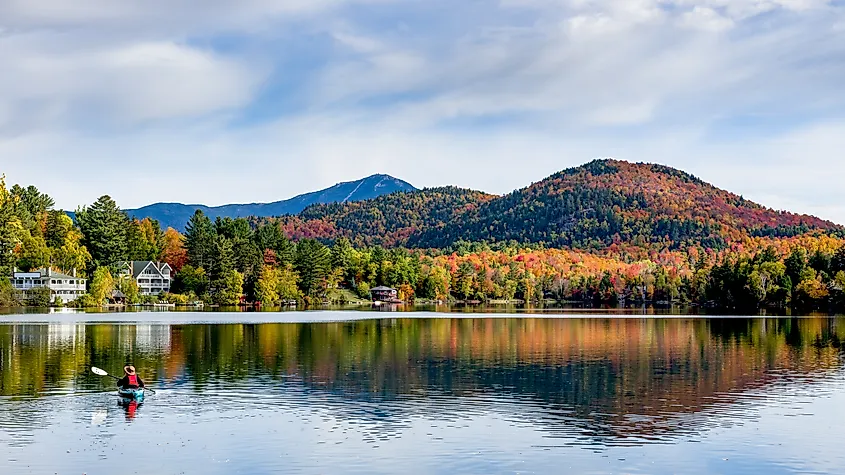
The Lake Placid Olympic Center, including the museum and historic 1932 rink, sits on Main Street and still functions as a community facility. Just east, the Lake Placid Pub & Brewery serves lunch and dinner with views over Mirror Lake. Mid-morning, retirees gather at Origin Coffee Co. for espresso and baked goods. On clear days, many drive 15 minutes to the summit of Whiteface Veterans’ Memorial Highway, which offers views into Vermont and Canada without requiring a hike.
Geneva
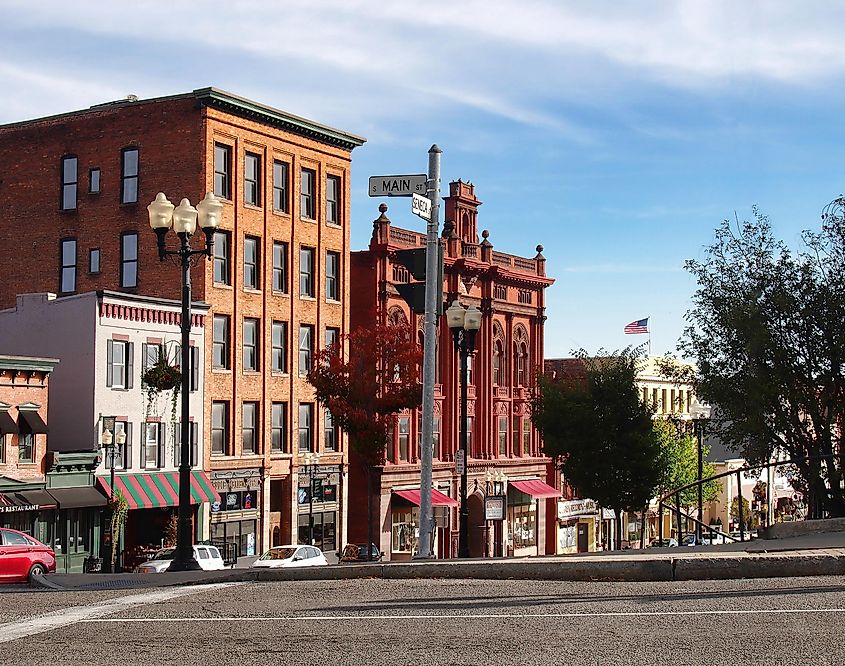
Geneva sits at the northern tip of Seneca Lake, where the water narrows and the terrain begins to roll into farmland. Its location places it within the Finger Lakes Wine Country, but Geneva functions less like a resort and more like a lakeside hub with working-class roots. The downtown core has a straight axis, exchange streets lined with banks, municipal offices, and red-brick storefronts, and everything slopes toward the lakefront. The Finger Lakes Welcome Center, built beside the public pier, includes a locally sourced café and full wine tasting room, with direct views of the marina and amphitheater lawn.
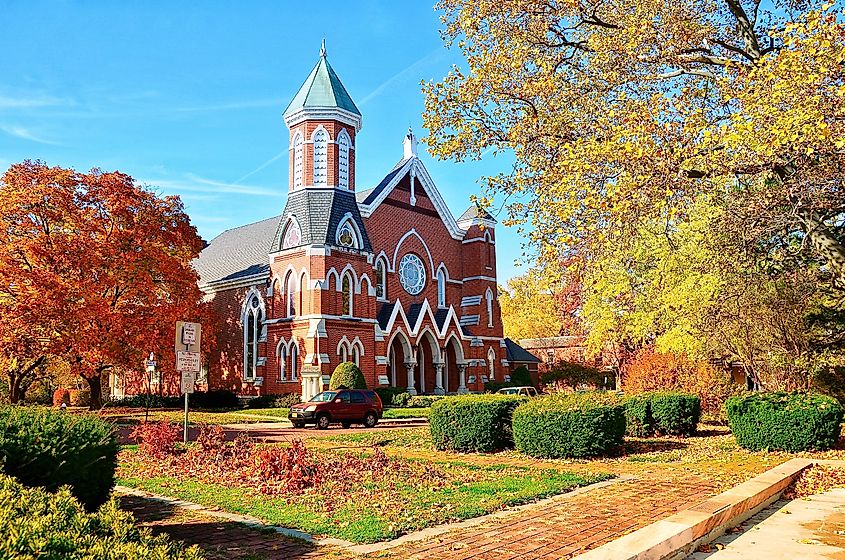
South Main Street holds the city’s most intact historic district. The row of limestone and clapboard houses overlooks the lake, terminating at Hobart and William Smith Colleges. On weekends, retirees walk the paved trails at Seneca Lake State Park or eat lunch at Kindred Fare, a restaurant just off Routes 5 & 20 focused on seasonal, regionally grown menus.
Canandaigua
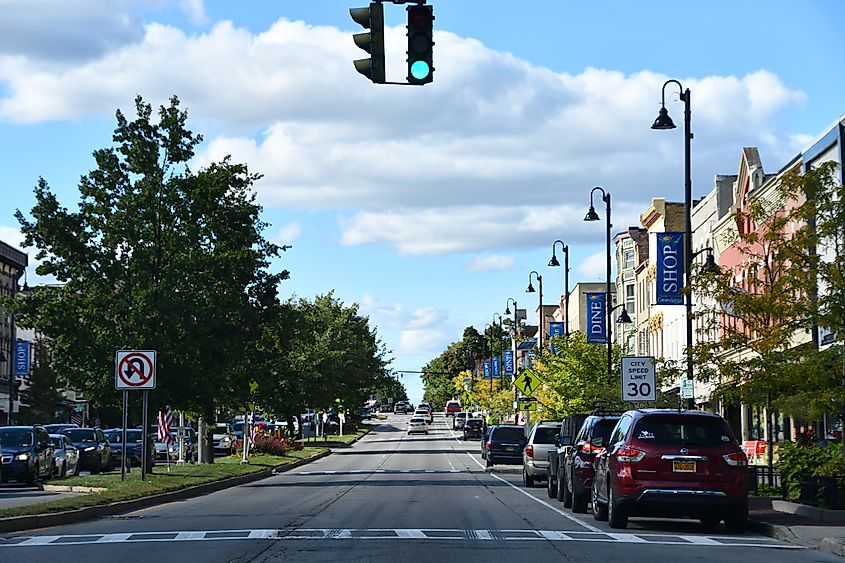
Canandaigua holds its name from a Seneca word meaning “the chosen spot,” and the geography backs that up. The town stretches along the northern end of Canandaigua Lake, a narrow glacial body with shallow entry points, consistent lake breezes, and a public beach less than a block from downtown. The city maintains direct access to the shoreline, with the Kershaw Park walkway tracing the edge from the boathouses to the marina. The hills to the south stay mostly undeveloped, preserving long sightlines across the water from the village.
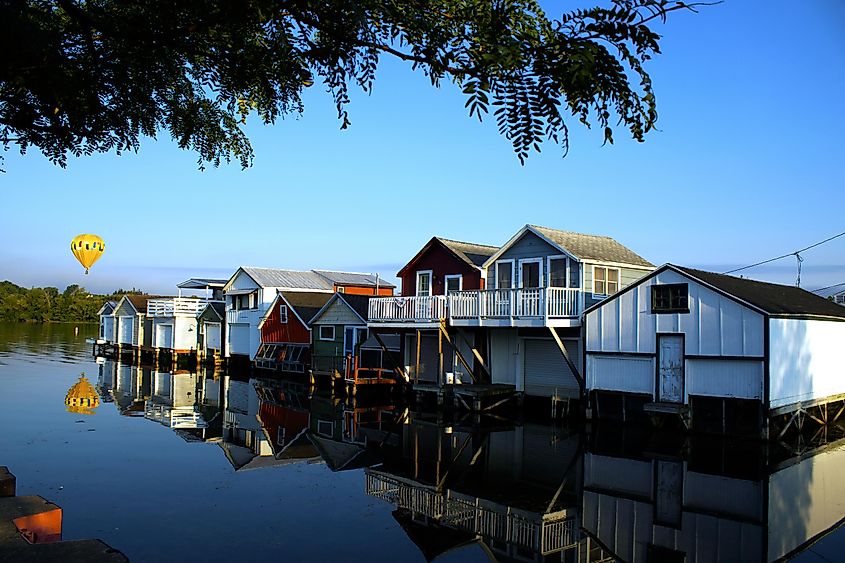
The Sonnenberg Gardens & Mansion, a 50-acre estate built in 1887, includes nine restored gardens and an original Queen Anne home, used today for tours and seasonal events. CMAC, a 15,000-seat performing arts venue set into the hills behind Finger Lakes Community College, brings in national acts but keeps its calendar limited to summer weekends. Just outside the walkable core, Granger Homestead & Carriage Museum houses more than 100 preserved 19th-century carriages in climate-controlled barns. For meals, Simply Crepes on Main Street serves early-day menus built around local fruit and dairy, and opens onto the central downtown block.
Skaneateles
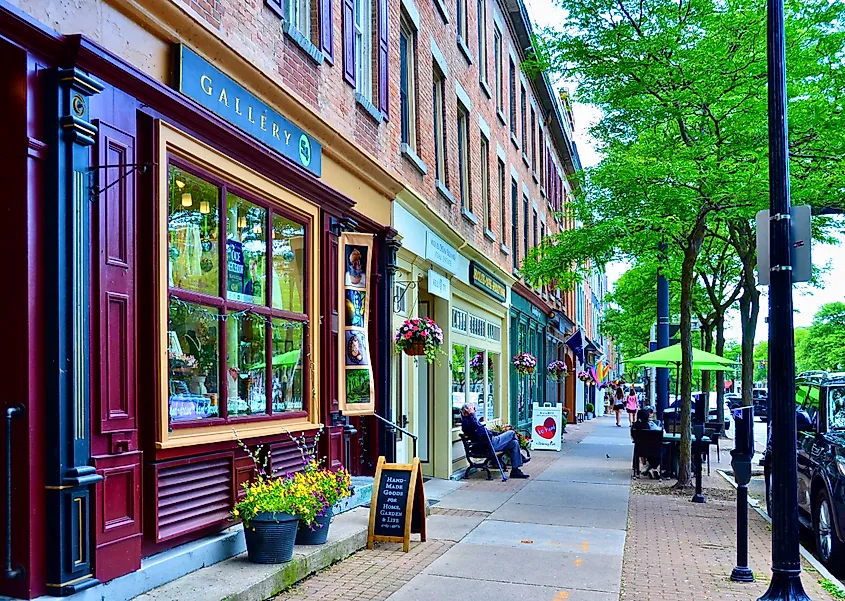
Skaneateles is one of the few towns in the Finger Lakes region where the lakefront is both central and uncluttered. The water remains among the clearest in New York State and serves as a municipal water source with no filtration plant, tapped directly into homes. The village occupies the northwestern corner of Skaneateles Lake, with a grid of residential streets that run parallel to Genesee Street, the commercial core. Stone piers and a public gazebo line Clift Park, and the lake’s steep drop-off near the shoreline makes it swimmable right from the village edge.
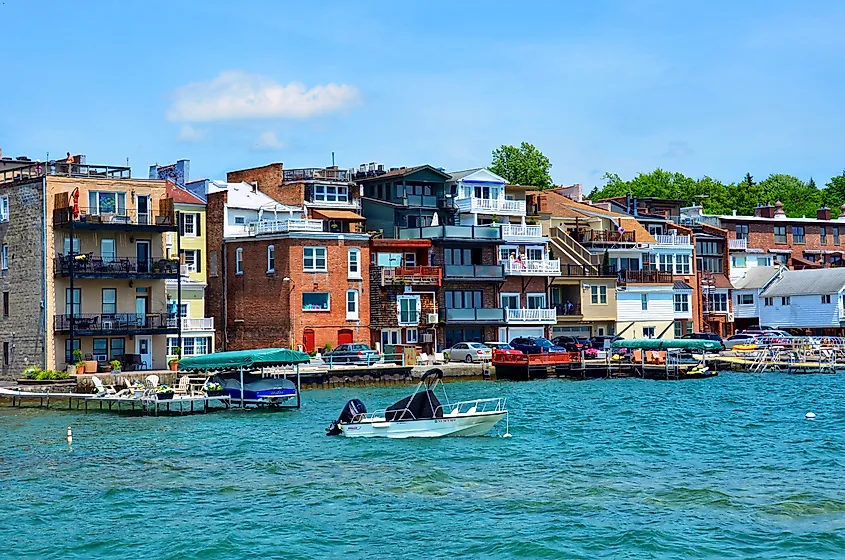
The Sherwood Inn anchors downtown, serving meals and lodging since 1807, directly across from the lake. A few doors down, Skaneateles Bakery offers walk-up service with daily bread and egg sandwich menus. Gallery 54, run as a cooperative, rotates regional artists monthly and sits beside the town’s main pedestrian crossing. From June through October, Mid-Lakes Navigation operates 90-minute sightseeing cruises from the public dock, looping the lake’s western side without requiring steep boarding ramps.
Corning
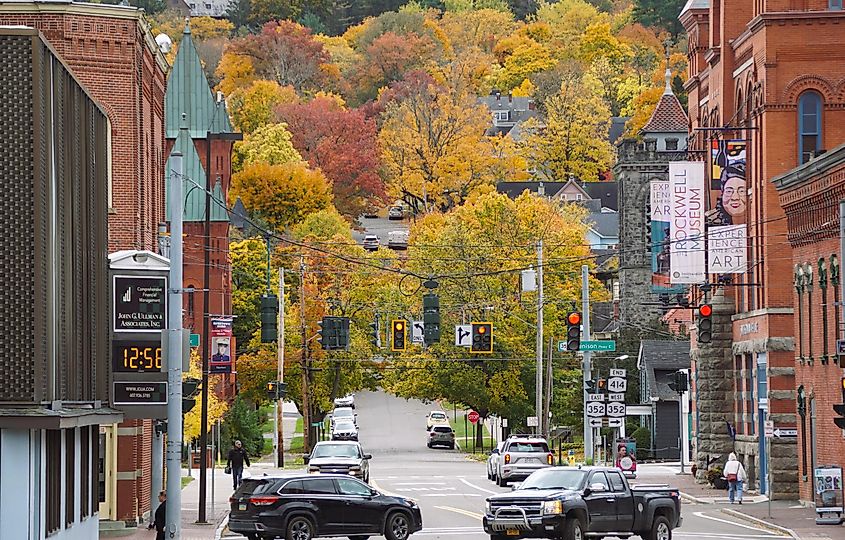
Corning’s entire downtown was rebuilt after a flood in 1972, but the city preserved the street plan and restored its 19th-century façades. As a result, the Gaffer District looks original but functions with updated infrastructure, making it unusually navigable for full-time residents. The town's identity is tied to glass, not just production, but design. Corning Incorporated remains headquartered here, and the Corning Museum of Glass anchors the northern end of town. The museum includes glassblowing demonstrations, permanent collections, and one of the largest contemporary glass galleries in the world.
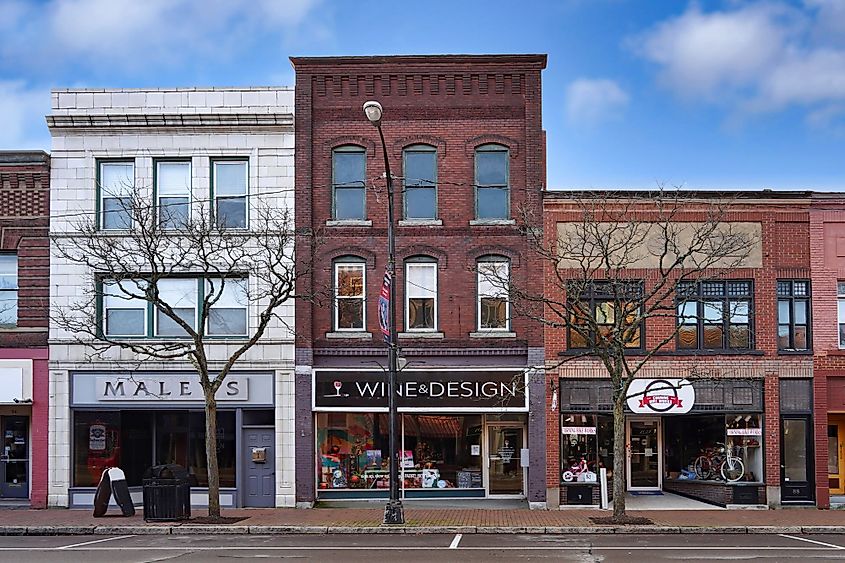
Market Street, the main commercial stretch, runs east to west with parallel parking, even sidewalks, and little traffic. Poppleton Bakery and Cafe opens daily for breakfast and early lunch in a former hardware store. Nearby, The Rockwell Museum holds collections of American art with rotating exhibitions tied to place and landscape. In summer, Riverfront Centennial Park is used for outdoor concerts and seniors’ tai chi classes. Everything downtown connects via walking paths and pedestrian bridges, including access to the paved trail along the Chemung River.
Hudson
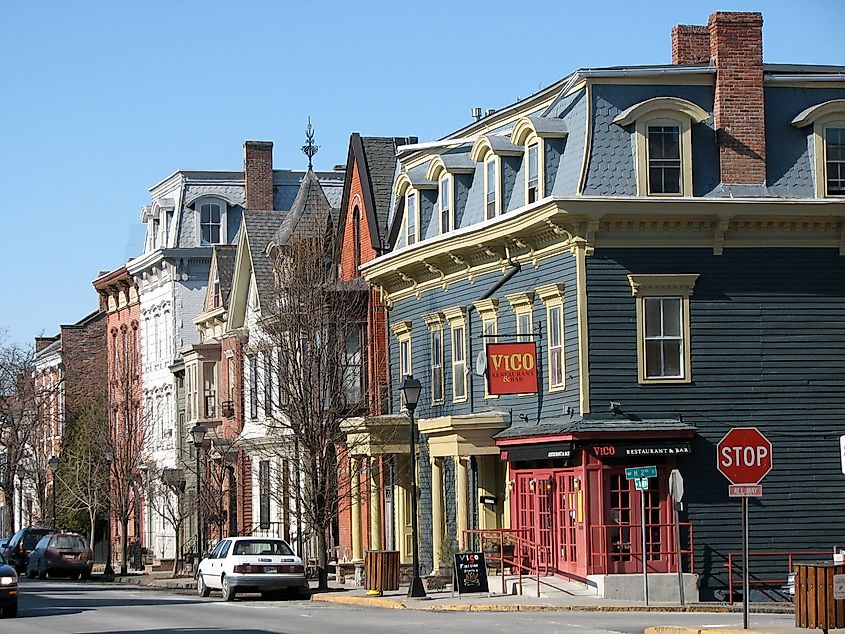
Hudson was a whaling port before it was a railroad town, before it was an antiques district, before it was a retreat for New York City artists. That layering still shows. The town rises steeply from the Hudson River, with a gridded street plan ending in a bluff that overlooks the Catskills. The Amtrak station is two blocks from the waterfront park, which holds seasonal events, permanent public art, and direct river access. Hudson remains one of the only small towns in the region with daily train service in both directions, north to Albany, south to Penn Station.
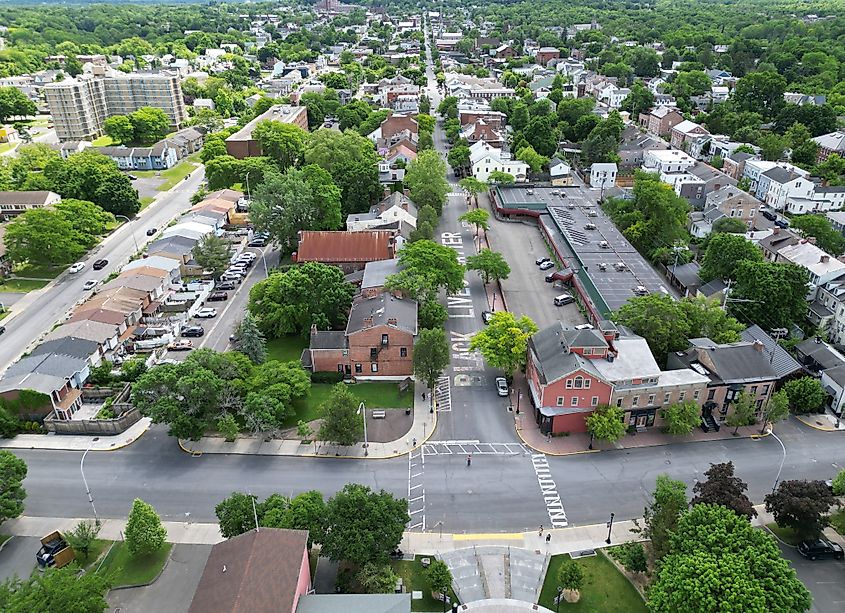
Warren Street, the main corridor, holds over a mile of commercial galleries, small restaurants, and reused industrial storefronts. Hudson Hall, originally the 1855 city hall, now runs year-round music, lecture, and chamber events from the restored upstairs theater. John Doe Books & Records sits near the center intersection and opens daily without appointment. For food, Café Mutton serves a tight brunch and lunch menu using local off-cuts and vegetables, and closes midafternoon. The Olana State Historic Site, former home of painter Frederic Church, lies just across the river and includes hilltop trails and original interiors.
Kingston
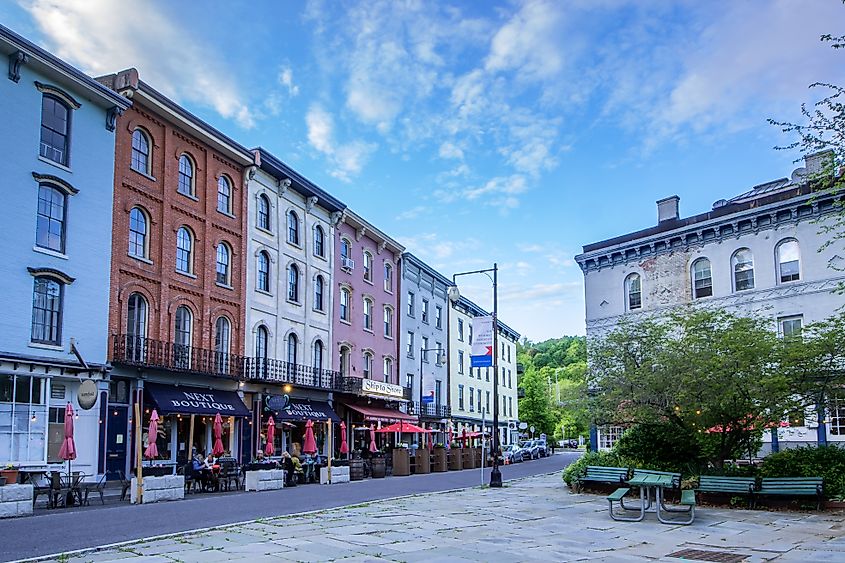
Kingston was the first capital of New York and the only city in the Hudson Valley with three separate historic districts, Uptown, Midtown, and Rondout. The Rondout waterfront faces the Hudson and includes repurposed canal-era buildings, a marina, and a rail-trail connection to the rest of the city. Unlike most river towns, Kingston sits at a navigable junction where the Rondout Creek meets the Hudson, once linking the Catskills to the Erie Canal. That layered infrastructure is still visible and walkable, with staircases, bridges, and wide brick sidewalks crossing the old shipping corridors.
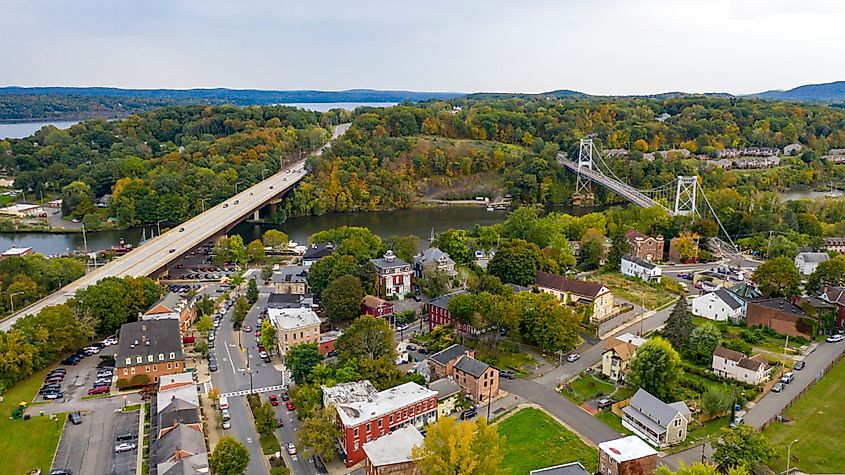
The Hudson River Maritime Museum anchors the Rondout district, with indoor exhibits and restored wooden boats docked in the basin. Nearby, the Trolley Museum of New York operates weekend service on original tracks running from the river to Kingston Point Park. For lunch, Rosie General offers rotisserie chicken and seasonal sides on Broadway, with seating inside a converted garage. The Old Dutch Church and surrounding Stockade District, further uphill, holds the oldest intersection in New York State still in use.
Plattsburgh
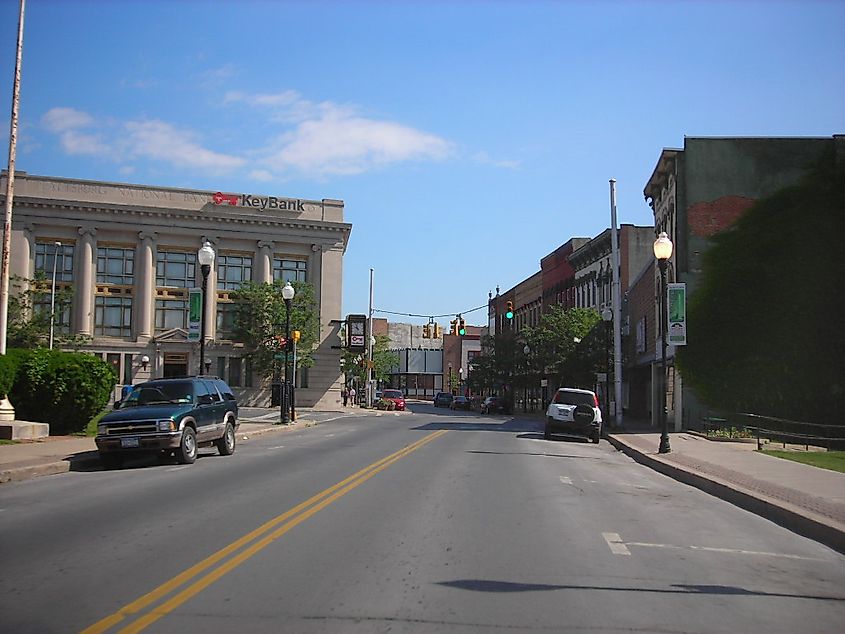
Plattsburgh is one of the few towns on Lake Champlain’s western shore with a wide, sandy beach directly inside city limits. The waterfront was originally part of a military base, but most of that land was converted for public use after the base closure in the 1990s. That transition opened up uninterrupted lake access for year-round residents. The downtown sits a few blocks inland, organized along Brinkerhoff and Margaret Streets, with the Saranac River cutting across and feeding into the lake. From late spring to early fall, the riverside trail system links neighborhoods to both waterfront and college grounds.
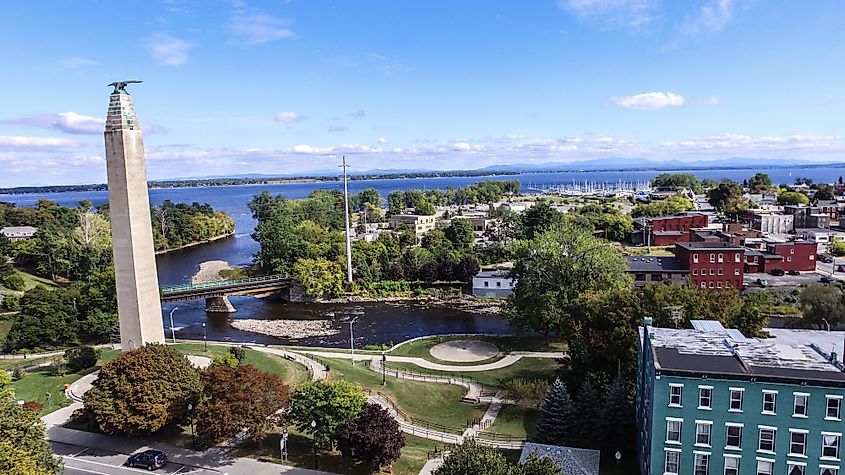
The Battle of Plattsburgh Interpretive Center marks the 1814 U.S. victory over British forces during the War of 1812 and sits near the foot of the MacDonough Monument. Strand Center for the Arts, housed in a restored 1924 theater, runs programming from regional chamber music to visual arts residencies. Chapter One Coffee & Tea serves breakfast, light lunches, and weekend jazz inside a converted bank. Just beyond the city line, Point Au Roche State Park offers flat trails through pine forests with lake views and winter snowshoe routes.
Elmira
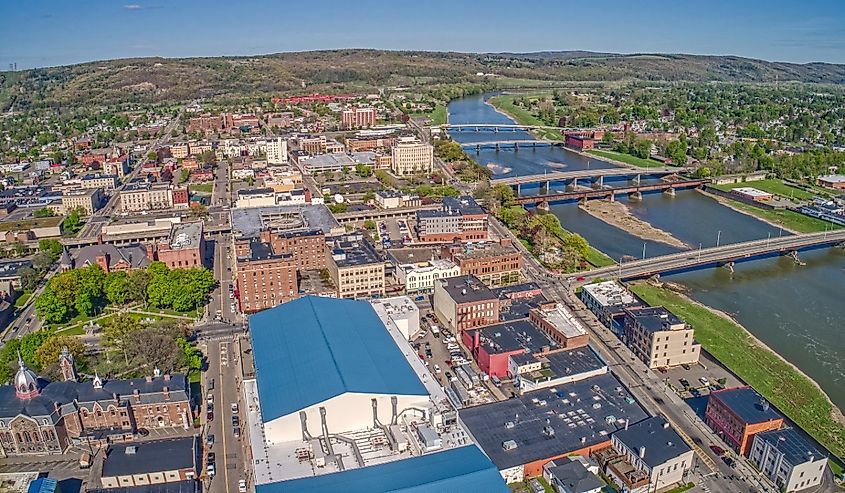
Elmira’s most permanent resident never lived there, Mark Twain summered in the city for over twenty years and is buried in Woodlawn Cemetery under the name Samuel Clemens. He wrote much of Adventures of Huckleberry Finn in a small octagonal study that still stands on the Elmira College campus. The town’s literary connection is specific but not decorative, Twain’s relationship with Elmira was tied to his in-laws, who were abolitionists, and to the Quaker culture that shaped parts of the city’s layout and civic tone. Many of the residential streets are wide, level, and lined with porches rather than garages.
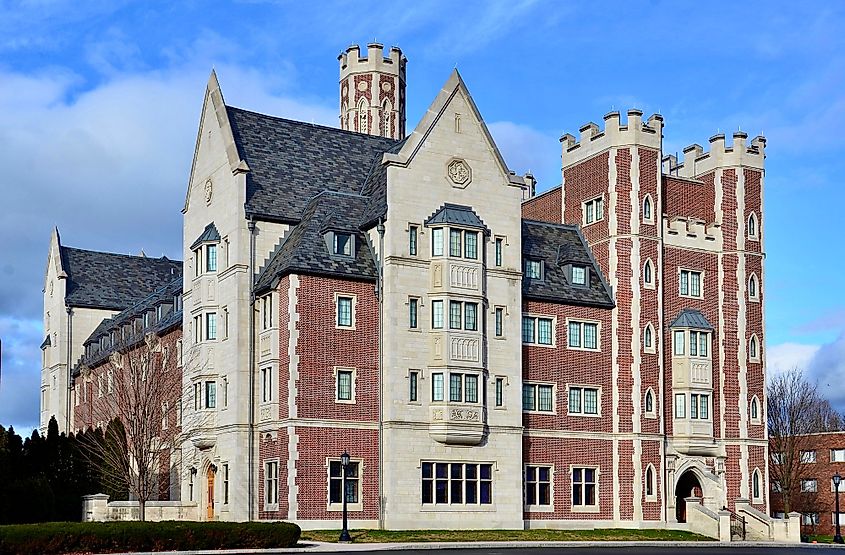
The Chemung River cuts through the southern half of Elmira, with paved trails running alongside for walking and biking. The Mark Twain Study is open seasonally, but the nearby Arnot Art Museum operates year-round with a focus on 19th-century American and European works inside a former Greek Revival bank. Harris Hill, a ridgeline just west of town, houses the National Soaring Museum and offers glider rides for visitors. Eldridge Park, once a trolley park, remains in operation with a restored 1890s carousel, lake, and walking loop.
Across these twelve towns, retirement reads like a clear map: compact downtowns, named anchors, and water at the edges setting the pace. Mornings start on lakeside paths, afternoons in museums or libraries, evenings at small venues built to last. Healthcare and groceries sit inside short drives; winters demand planning, not retreat. Upstate New York isn’t a compromise, it’s a practical landscape with character, calibrated for long stays and steady days ahead.

